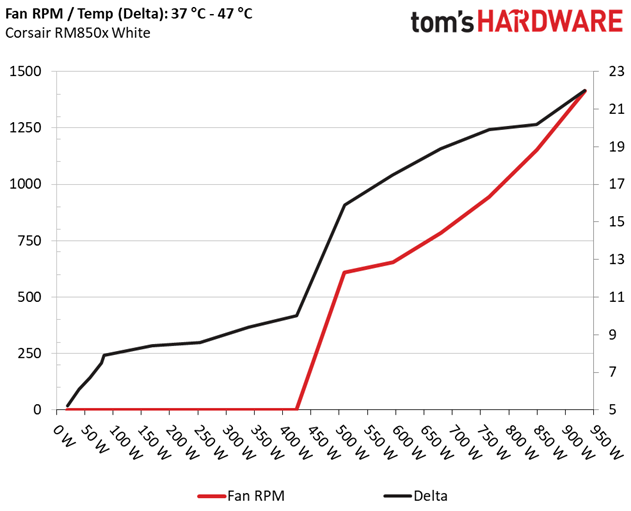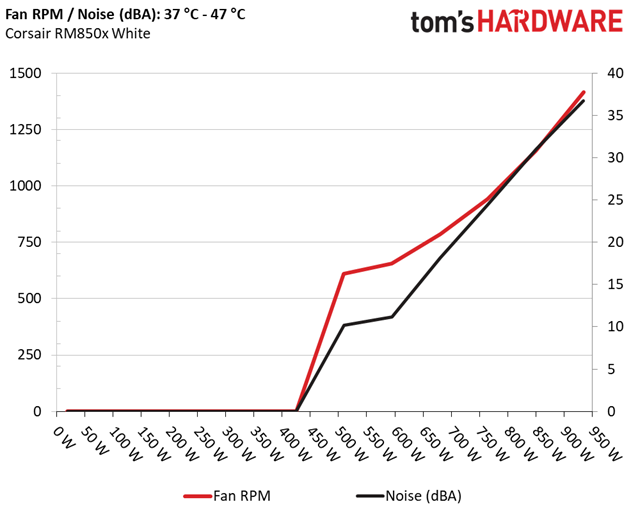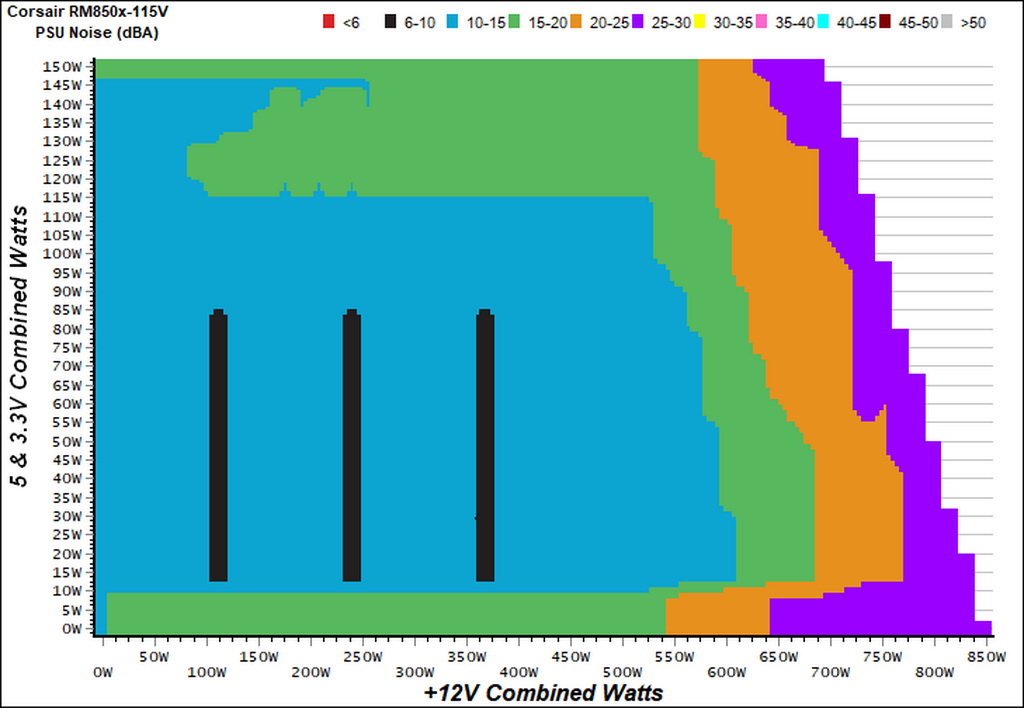Corsair RM850x White PSU Review
Why you can trust Tom's Hardware
Efficiency, Temperature & Noise
Efficiency
Our efficiency testing procedure is detailed here.
Using results from the previous page, we plotted a chart showing the RM850x's efficiency at low loads, and loads from 10 to 110 percent of its maximum-rated capacity.

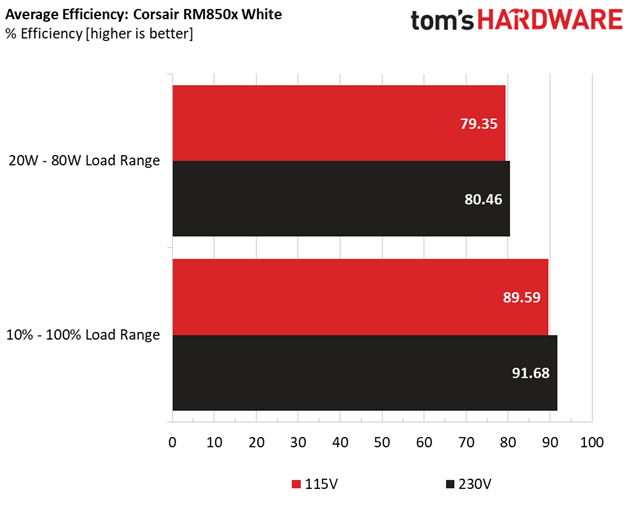
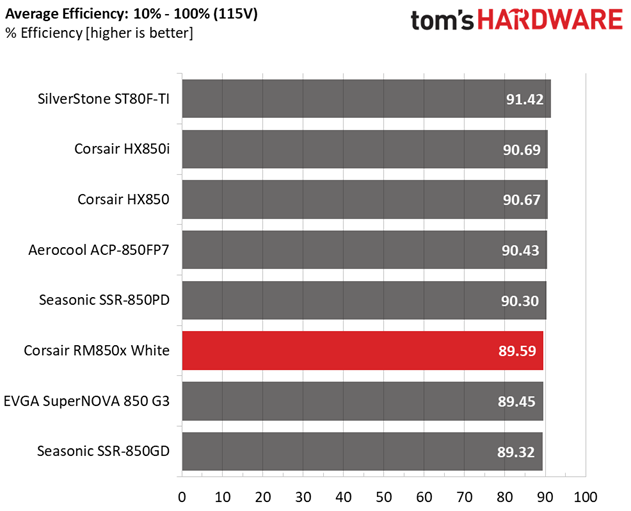
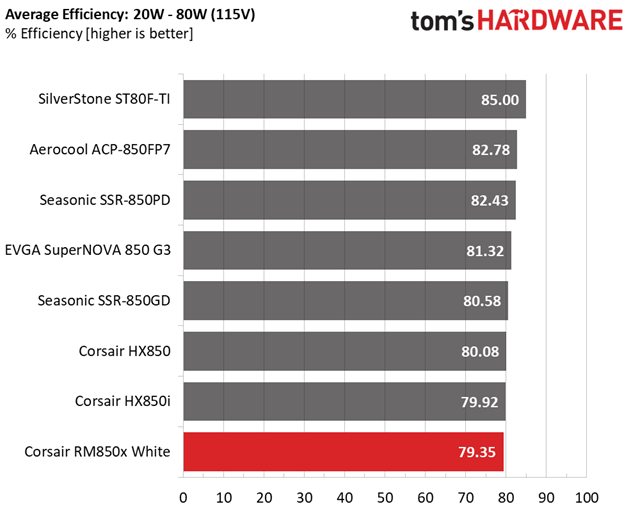
Compared to similar-capacity units with the same 80 PLUS rating, Corsair's RM850x fares well under normal loads. Under light loads, it doesn't land far from its competition. However, it does land in last place.
Efficiency At Low Loads
In the following tests, we measure the RM850x's efficiency at loads significantly lower than 10 percent of its maximum capacity (the lowest load the 80 PLUS standard measures). The loads we dialed were 20, 40, 60, and 80W. This is important for representing when a PC is idle, with power-saving features turned on.
| Test # | 12V | 5V | 3.3V | 5VSB | DC/AC (Watts) | Efficiency | Fan Speed | PSU Noise | PF/AC Volts |
|---|---|---|---|---|---|---|---|---|---|
| 1 | 1.166A | 0.492A | 0.477A | 0.199A | 19.214 | 67.377% | 0 RPM | <6.0 dB(A) | 0.824 |
| 12.131V | 5.040V | 3.327V | 5.036V | 28.517 | 115.24V | ||||
| 2 | 2.418A | 0.988A | 0.989A | 0.397A | 39.592 | 80.151% | 0 RPM | <6.0 dB(A) | 0.930 |
| 12.128V | 5.040V | 3.326V | 5.032V | 49.397 | 115.22V | ||||
| 3 | 3.608A | 1.485A | 1.470A | 5.028A | 59.123 | 83.758% | 0 RPM | <6.0 dB(A) | 0.954 |
| 12.126V | 5.040V | 3.325V | 5.028V | 70.588 | 115.19V | ||||
| 4 | 4.863A | 1.980A | 1.982A | 0.796A | 79.521 | 86.122% | 0 RPM | <6.0 dB(A) | 0.965 |
| 12.123V | 5.039V | 3.325V | 5.024V | 92.335 | 115.17V |
We would like to see over 70% efficiency in the 20W load test, but the RM850x doesn't pull this off. In the other three tests, though, efficiency exceeds the 80% mark.
In each test, the RM850x operates in passive mode. Noise output is naturally negligible.
5VSB Efficiency
The ATX specification, along with CEC, ErP Lot 3 2014 and ErP Lot 6 2010/2013, states that 5VSB standby supply efficiency should be as high as possible, recommending 75 percent or higher with 550mA, 1A, and 1.5A of load. The PSU should also achieve higher than 75% efficiency at 5VSB under full load, or with 3A if its max current output on this rail is higher than 3A.
Get Tom's Hardware's best news and in-depth reviews, straight to your inbox.
We take six measurements: one each at 100, 250, 550, 1000, and 1500mA, and one with the full load the 5VSB rail can handle.
| Test # | 5VSB | DC/AC (Watts) | Efficiency | PF/AC Volts |
|---|---|---|---|---|
| 1 | 0.100A | 0.506 | 76.090% | 0.055 |
| 5.054V | 0.665 | 115.27V | ||
| 2 | 0.250A | 1.263 | 79.937% | 0.123 |
| 5.051V | 1.580 | 115.27V | ||
| 3 | 0.550A | 2.774 | 81.684% | 0.227 |
| 5.043V | 3.396 | 115.28V | ||
| 4 | 1.000A | 5.033 | 81.891% | 0.320 |
| 5.033V | 6.146 | 115.27V | ||
| 5 | 1.500A | 7.531 | 81.841% | 0.375 |
| 5.021V | 9.202 | 115.27V | ||
| 6 | 3.000A | 14.954 | 80.846% | 0.449 |
| 4.985V | 18.497 | 115.26V |

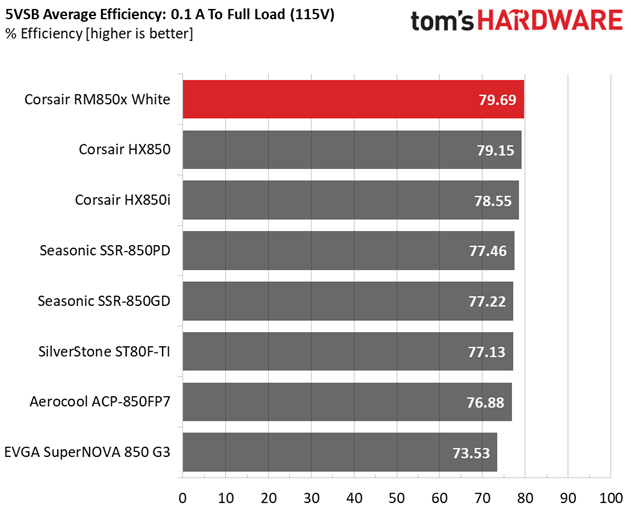
Besides great load regulation, the 5VSB rail is also highly efficient. Once more, CWT shows that it builds high-performance 5VSB circuits into its platforms.
Power Consumption In Idle And Standby
In the table below, you'll find the power consumption and voltage values of all rails (except -12V) when the PSU is idle (powered on, but without any load on its rails), and the power consumption when the PSU is in standby mode (without any load, at 5VSB).
| Mode | 12V | 5V | 3.3V | 5VSB | Watts | PF/AC Volts |
|---|---|---|---|---|---|---|
| Idle | 12.133V | 5.041V | 3.328V | 5.041V | 8.563 | 0.440 |
| 115.3V | ||||||
| Standby | 0.048 | 0.004 | ||||
| 115.3V |
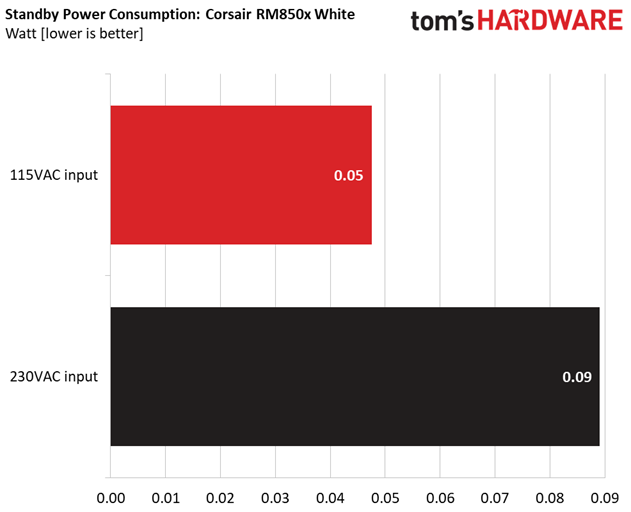
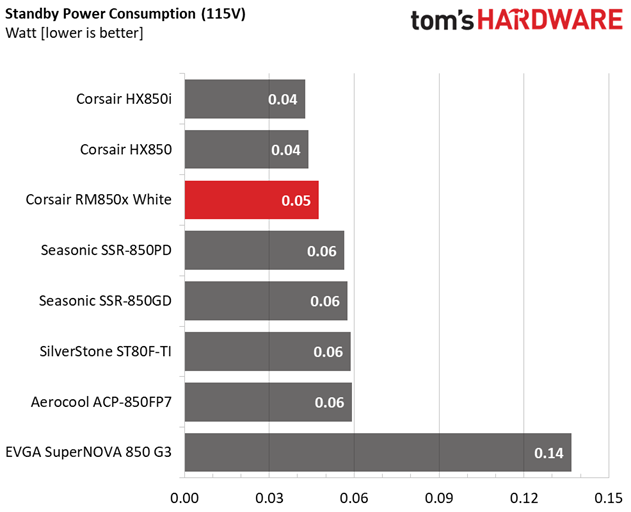
Power consumption in standby mode is pretty low with both voltage inputs (115V and 230V).
Fan RPM, Delta Temperature, And Output Noise
Our mixed noise testing is described in detail here.
The first chart below illustrates the cooling fan's speed (in RPM), and the delta between input and output temperature. The results were obtained at 37°C (98.6°F) to 47°C (116.6°F) ambient temperature.
The next chart shows the cooling fan's speed (again, in RPM) and output noise. We measured acoustics from one meter away, inside a hemi-anechoic chamber. Background noise inside the chamber was below 6 dB(A) during testing (it's actually much lower, but our sound meter’s microphone hits its floor), and the results were obtained with the PSU operating at 37°C (98.6°F) to 47°C (116.6°F) ambient temperature.
The following graph illustrates the fan's output noise over the PSU's operating range. The same conditions of the above graph apply to our measurements, though the ambient temperature was between 30°C (86°F) to 32°C (89.6°F).
Corsair's passive mode doesn't last long in our cross-load tests. In fact, it's totally overlapped by the next level/color (6-10 dB[A]/black). Somewhere in the center of the black bars, the PSU runs without its fan spinning, but just briefly. We have seen this before from CWT platforms. Once you push the minor rails hard, the cooling fan starts spinning. This might be a glitch, or CWT simply believes it's important to cool the minor rails well once their FETs start working overtime.
MORE: Best Power Supplies
MORE:How We Test Power Supplies
Current page: Efficiency, Temperature & Noise
Prev Page Load Regulation, Hold-Up Time & Inrush Current Next Page Protection Features
Aris Mpitziopoulos is a contributing editor at Tom's Hardware, covering PSUs.
-
stairmand I've got one of these and wish I had bought a different PSU and paid for cable mods instead. The in line caps are not too big a deal (lets not forget the whole point of the colour and cables IS the aesthetics) but the way the PCIe cables are wired (in a Y config) is terrible and makes it very hard to neatly cable.Reply
The combes are also relatively poor quality and don't clip together brilliantly especially as there are multiples wires used in a couple of pins. -
vapour Looks nice, but seems to behind Seasonic Focus Point and EVGA Supernova G2. Make better psus, Corsair!Reply -
feelingtheblanks Hey Aris,Reply
Is there a possibility to retest one of those Evga Supernova G2 units, like G2 750, in terms of the new hold-up time tests?
I read your Leadex Gold 550 review, where you find out the hold up time of that unit (and maybe the whole platform) is questionable and not really safe. So that made me think that the rest of the platform and also the Evga units are plagued by the same important mistake.
I own a G2 750 and after reading that review and some forum threads, I'm a bit worried now.
Hope you can help.
Best -
turkey3_scratch Reply20451514 said:Looks nice, but seems to behind Seasonic Focus Point and EVGA Supernova G2. Make better psus, Corsair!
RMx have always been better than the G2 because they're quieter. -
feelingtheblanks Reply20453647 said:Unfortunately I don't have any G2 units any more, to test for hold-up time.
Thanks for the answer Aris,
Do you think that these units are safe though? G3 850 seems fine on your tests. Are there dramatic differences between G2 750/850 and G3 850 in terms of bulk caps etc...? You have a rough estimation maybe?
Best
-
Aris_Mp I believe that the G2s are pretty good units and I would't hesitate to use them. Unfortunately I cannot estimate their hold-up time without testing them (something impossible now since they are EOL).Reply -
turkey3_scratch Reply20454054 said:20453647 said:Unfortunately I don't have any G2 units any more, to test for hold-up time.
Thanks for the answer Aris,
Do you think that these units are safe though? G3 850 seems fine on your tests. Are there dramatic differences between G2 750/850 and G3 850 in terms of bulk caps etc...? You have a rough estimation maybe?
Best
I looked into it before. The 650 G2 most likely has the problem where it drops the PWR_OK signal after the voltages go out of spec. The 550W should be fine. I'd assume the 750W is perfectly fine also. Not something to worry much about anyway. -
turkey3_scratch Reply20454749 said:My previous corsair GS700 fried my motherboard(lasted only 2 years of mild use)..
Pretty sure those were some of the most unreliable units in history. RMA rates above 10% I believe.
